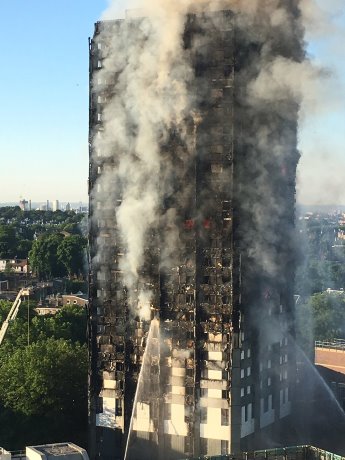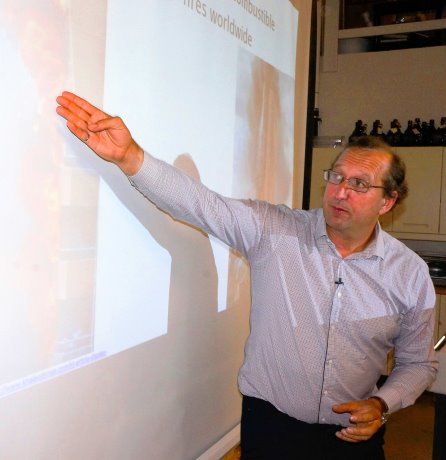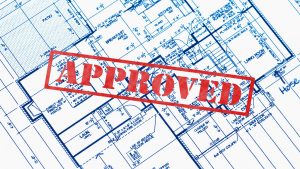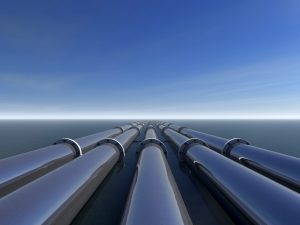The tragic Grenfell Tower fire that took place in London in June might have been avoided if a fire-rated, non-combustible metal composite material (MCM) panel, such as one containing a core of limestone and other fireproof minerals, had been installed on the building’s exterior.
While the fire that killed approximately 79 people remains under investigation, the MCM Arconic cladding specified as being used on the building was comprised of a 0.5 millimetre layer of aluminum sandwiching a polyethylene core, which is a combustible material, says John Straube, a principal of RDH Building Science Inc.
The tower was built in the 1970s but Arconic cladding was added recently as part of an energy retrofit.
Straube presented on fire and building enclosures as part of the company’s Learning About Building Event seminar series at its offices in Waterloo, Ont. He stressed the importance of taking into account fire safety in the design of the building envelope — including insulation types and other materials comprising the cladding system.
All parties in a project should collaborate early on to avoid expensive building holdups later.
"You can’t just switch out materials without careful thought," he says.
Communication between "the people who want to stop a building from leaking, the people who want it to be energy efficient and all of us who don’t want it to burn" is integral to the success of the project, he says.
Straube, who has been involved in forensic investigations into building failures and is an expert in leading-edge building envelope science, says that compartmentalizing each floor in a tower "is a good idea" and can often be done with cross cavity flashings.
While Grenfell appears to have had a floor-to-floor firestop, it is unclear if it was installed in the cavity between the metal panel and the face of the insulation. Without that flashing, it is possible that the two-inch cavity would be enough to start a "chimney fire effect," he told the audience.
Cladding manufacturers that produce combustible materials have developed energy efficient systems that meet fire codes. A good example is in the Exterior Insulation and Finish Systems (EIFS) industry. EIFS producers wrap their product in a fire-rated material.
"It’s important to make sure that wrapping goes all the way around that EPS, not just for performance of shrinkage and cracking, but also from a fire test point of view," he said.
In highrises with combustible exteriors, fires can move quickly up a building. Fires move sideways about one-seventh the speed, he says.
Straube believes the Grenfell fire is not likely to occur in Canada.
"Much of what we are doing here is right," he explains. "There are many things that are very different in the U.K. and the Grenfell tower than we are used to in our area of work."
Over the past century or so there have been about 25 significant building fires that have helped shape today’s regulations and standards. One of those was the Hilton Las Vegas fire in 1981 where eight people died after flames spread quickly up the 30-storey structure. The fire impacted future building enclosure design, Straube told the audience.
But while design and fire safety regulations have improved over the past 50 years, they have not always been enforced, he says.
Still, the odds of dying in a highrise fire in Canada are low — about 2.5 times less than in a two- or three-storey townhouse — because of higher fire protection requirements in buildings over six storeys.
U.S. stats indicate that 94 per cent of fires were confined to the room of origin and 4.3 per cent to the floor of origin. Only 1.7 per cent spread beyond the floor of origin, he says. Fires often spread inside because of failures at transitions and penetrations.
Straube points out that in the U.S. the National Fire Protection Association now routinely hires third-party experts to investigate serious fires, including what code, standards and enforcement limitations there might have been. The problem is that the investigations take up to three years.
Straube says there is little "good science" for non-standard solutions to improving fire ratings inside buildings. Increasing a wall from a one-hour to a two-hour fire rating is an example that requires tests, "which almost never inform the science" for future applications.
A fire research centre at the University of Waterloo, however, conducts tests that "create science so we will know what to do next time."












Recent Comments
comments for this post are closed